“The Alternative Factor”
Written by Don Ingalls
Directed by Gerd Oswald
Season 1, Episodes 20
Production episode 6149-20
Original air date: March 30, 1967
Stardate: 3087.6
Captain’s log. The Enterprise is finishing up an orbital survey of an uninhabited planet, when they’re buffeted by some kind of force. According to Spock, for an instant the magnetic field of the solar system disappeared and the planet below had no mass—it was as if reality winked out of existence for a second. As soon as the phenomenon abated, a humanoid life sign reading appeared on the planet out of nowhere.
Kirk, Spock, and a four-person security detail beam down to investigate. They find a small, one-person ship—which, weirdly, Spock’s sensors did not pick up—and its pilot, who is ranting and raving and then faints.
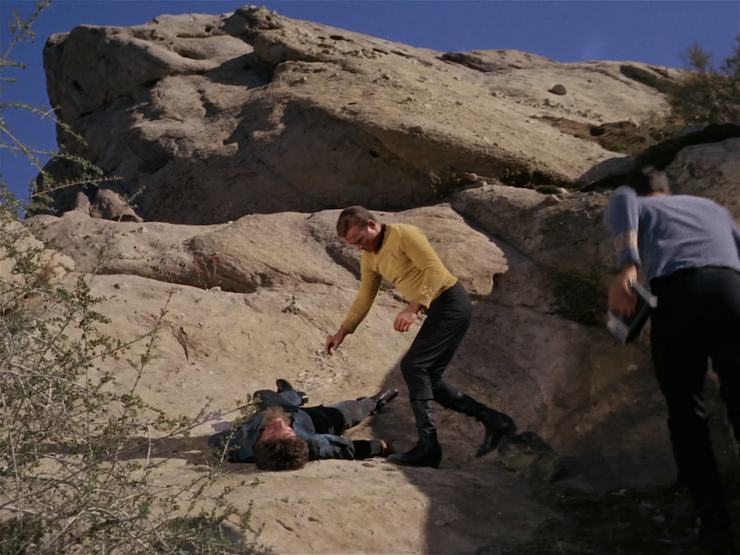
They beam him back to the ship. Lieutenant Charlene Masters reports that the dilithium crystals have been reduced in power and energy. Spock can find no further signs of disturbance, while the ship’s pilot is recovering in sickbay. Commodore Barstow reports that the phenomenon was galaxy-wide at the very least, and it was centered on the sector the Enterprise is in. The rest of Starfleet is preparing for a possible invasion and so can render no assistance, so the Enterprise is on its own to figure out what’s happening.
Kirk interviews their guest, who’s named Lazarus, and who claims to be chasing a murderer across the universe. This person—this thing—murdered his entire civilization. Lazarus was the only survivor, and also blames his enemy for the winking out of the universe.
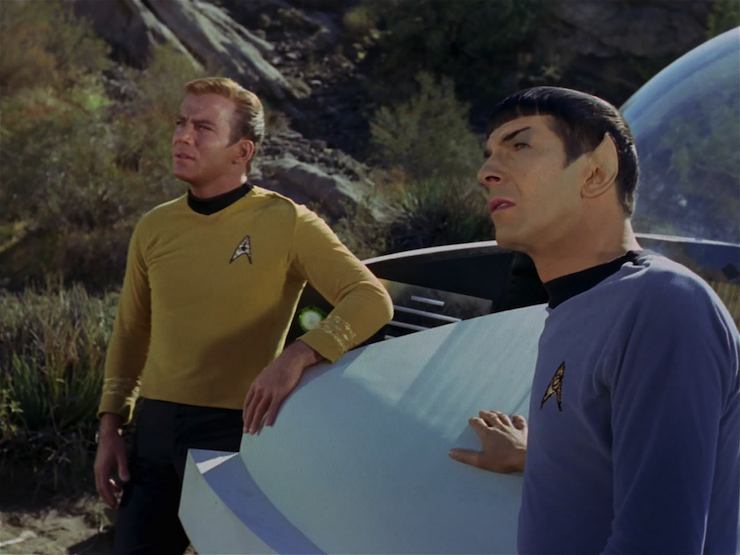
Kirk and Lazarus beam down, where Spock and an engineer are going over Lazarus’s ship. Spock can find no sign of another life, and accuses Lazarus of lying. Before he can defend himself, Lazarus is attacked, seemingly by nothing—and then he seems to be transported to a place where everything looks like a negative image, where he and an identical form struggle. After a minute, he’s returned to the real world, claiming to have struggled with his enemy. The winking out phenomenon happened again during the struggle.
Lazarus is injured and treated by McCoy—but the cut on his forehead heals almost instantly. He goes to the mess hall and overhears Masters discussing the dilithium crystals with another engineer, while bitching about the quality of the Enterprise coffee. When Lazarus goes into the corridor, he again struggles with his enemy—and when he’s done, the wound and the bandage are back on his head.
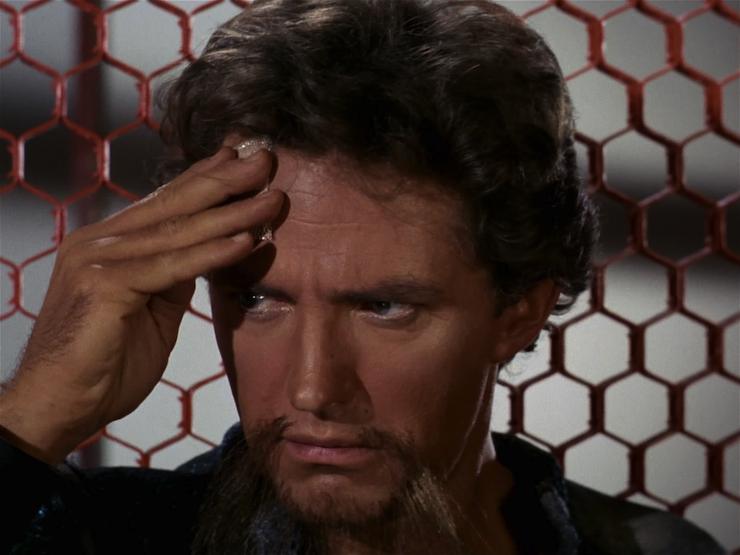
Spock reports that the Enterprise is picking up a radiation reading, but there is no trace of any source for the radiation. Spock hypothesizes that it’s a rip in the very fabric of the universe. The dilithium crystals can apparently detect the radiation. Lazarus begs Kirk to let him have the Enterprise‘s crystals, as it’s the only way he can stop his enemy, but Kirk won’t sacrifice his ship’s power source.
Lazarus leaves the bridge in a huff; the security guard assigned to him has to wait for the next turbolift to follow. Lazarus again has a conflict with his enemy—and then the bandage is gone again. He goes to engineering, takes out Masters’s assistant, and then Masters herself while she’s talking to the captain.

By the time they track Lazarus down, he’s got the bandage again (and his beard has thinned considerably), and two dilithium crystals are missing. Lazarus blames his enemy. Kirk orders a search of the ship, and then takes Spock and a security detail to investigate Lazarus’s ship—no sign of the crystals. Also Lazarus’s beard has gotten incredibly thick. Spock has also lost the radiation signature. They search the area on foot. For reasons passing understanding, Kirk lets Lazarus go off on his own—and he confronts his enemy again, and afterward he falls from a great height.
He’s brought to the Enterprise, where Kirk confronts him with the fact that there’s no planet at the location where he said his home world was, and there never has been. Lazarus confesses to being a time traveler, as is his enemy. They have fought across the centuries. Lazarus collapses from his injuries.
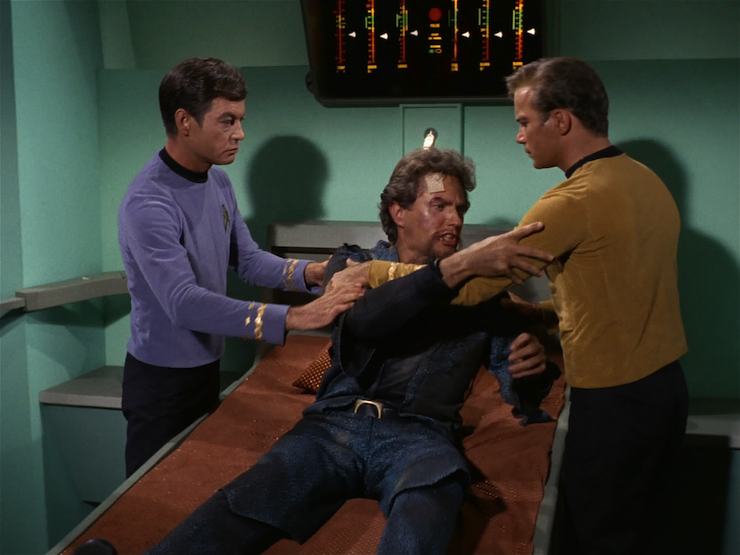
Since their instruments can’t detect the source of the radiation, Spock hypothesizes that it comes from outside their universe. Lazarus’s enemy could come from a parallel universe. Lazarus has shown two separate personalities, his wound has come and gone, and it seems obvious now that there are two different versions of Lazarus—the hole in the fabric of space they found could be a doorway between universes. Spock believes that one is a universe of matter, the other a universe of anti-matter, which is why their conflicts have winked out the universe. If allowed to go on, the universe could be destroyed.
Lazarus sabotages an engineering console, setting a fire. He uses the cover of the fire to steal dilithium crystals, then beams down to the planet, beating up the transporter chief en route. Kirk beams down to go after Lazarus, ordering Spock to follow with a security detail. Lazarus installs the crystals into his ship. Kirk enters Lazarus’s ship—
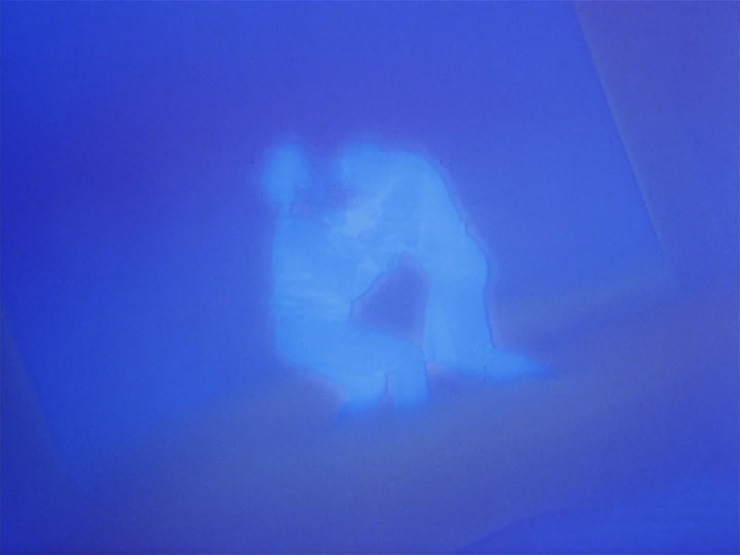
—and then finds himself in the same limbo where the Lazarus-Lazarus action has been taking place. After a few moments, he’s back on the planet, but it’s night-time and Lazarus’s ship has moved and is badly damaged. The other Lazarus, the one without the bandage, is repairing the ship.
Their fights are endangering both universes. The Lazarus from the matter universe went mad when he discovered that he had an anti-matter counterpart. The anti-matter Lazarus proposes that Kirk lure the matter Lazarus into the limbo between universes—Lazarus calls it a corridor—and then destroy Lazarus’s ship, which will also (apparently) destroy the equivalent ship in the other universe.
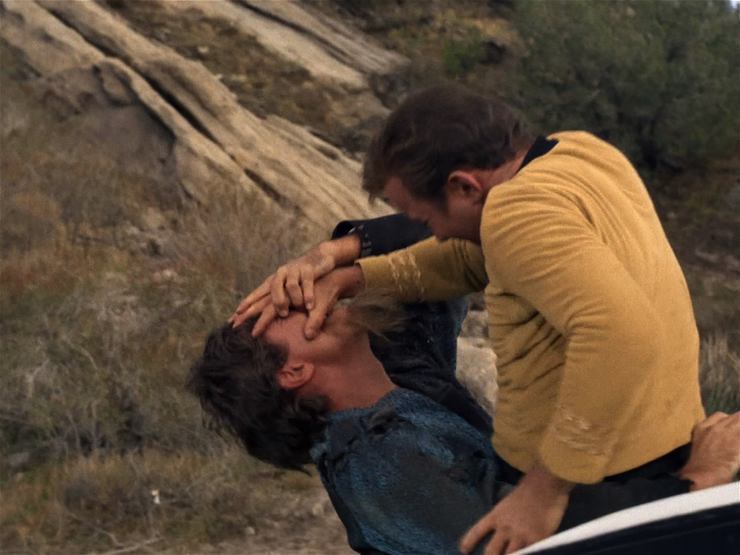
Kirk goes through to the matter universe, where Spock and the security detail have Lazarus surrounded. Kirk gets into a prolonged fistfight and then he sends Lazarus into his ship, which puts him in the corridor. The landing party beams up, and Kirk orders Leslie to destroy Lazarus’s ship. The two Lazaruses are left to fight in the corridor for all eternity.
Can’t we just reverse the polarity? It’s established that the crystals used to power ships with warp drive are dilithium crystals, retconned from the lithium crystals in “Mudd’s Women,” a change no doubt made when someone pointed out that lithium doesn’t come in crystalline form. However, the episode contradicts what was established in “The Naked Time,” to wit, that the crystals channel the power from the annihilation of matter and anti-matter. Indeed, Kirk and Spock talk as if anti-matter is theoretical in this episode, and the crystals themselves are what provide the power. This notion will never be referred to again, and henceforth it’ll be back to what “Mudd” and “Naked” set up.

Fascinating. Leonard Nimoy very obviously had a cold the week this was filmed, as he sounds horribly stuffed-up…
I’m a doctor not an escalator. McCoy insists that the security guard in sickbay standing over Lazarus be dismissed, and then assures Kirk that Lazarus won’t leave sickbay this time. McCoy then leaves the room, and Lazarus immediately gets out of bed and leaves sickbay. Good work, Bones!
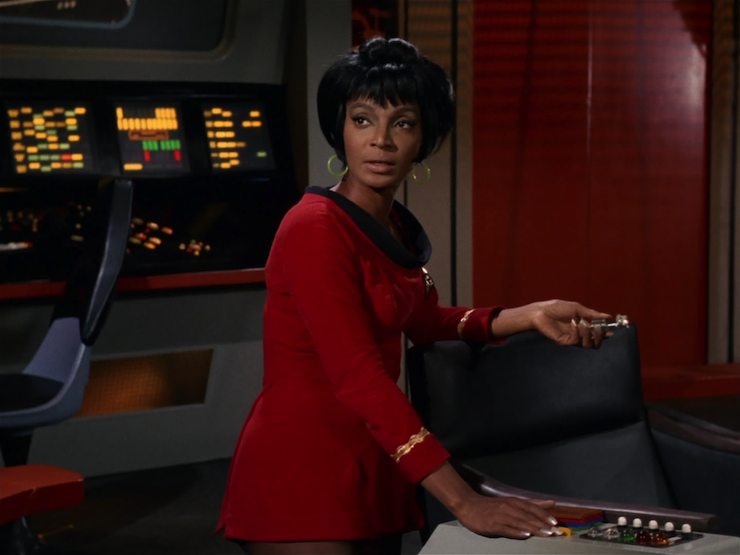
Hailing frequencies open. At one point, Uhura is standing next to the captain’s chair and using the controls on the arm of it, rather than sitting at her own console. Since they never let her command the ship, I guess she had to get her command jollies where she could. (At one point, Leslie is seen to be in command of the bridge while Kirk and Spock are away.)
Go put on a red shirt. Security actually comports themselves well, with a full detail beaming down to the planet on three different occasions (which should have happened more often), and also taking care of the fire in engineering.
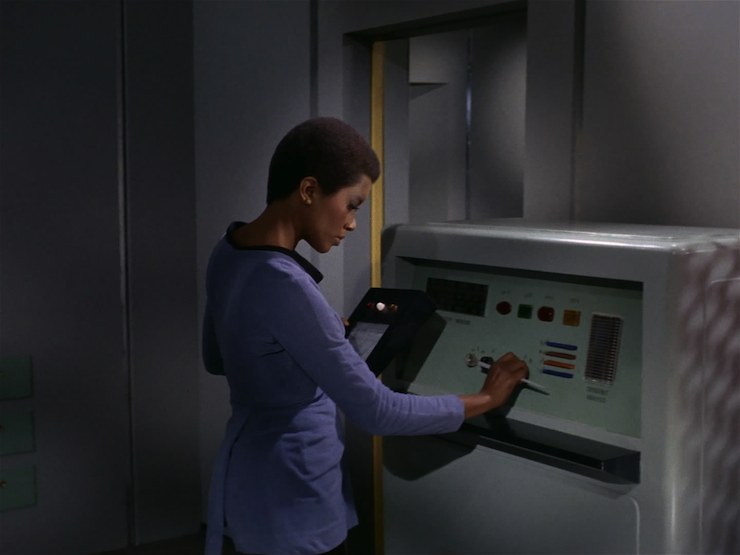
No sex, please, we’re Starfleet. Originally there was supposed to be a romance between Lazarus and Masters, but Gene Roddenberry asked for that element to be removed as it was too similar to the romance between Khan and McGivers in the upcoming “Space Seed.” The fact that it would have been a romance between a black woman and a white man may have been why this one had the kibosh put on it rather than the other.
Channel open. “I fail to comprehend your indignation, sir. I’ve simply made the logical deduction that you are a liar.”
Spock, who needs work on his indignation comprehension skills.

Welcome aboard. Robert Brown plays both iterations of Lazarus, with varying beard thickness, while Janet MacLachlan plays Masters, Arch Whiting plays her unnamed assistant, Richard Derr plays Barstow, Christian Patrick plays the transporter chief, and Eddie Paskey actually gets billing this time around as Leslie (though the character name is misspelled “Lesley” in the credits). Plus we’ve got recurring regulars DeForest Kelley and Nichelle Nichols.
Trivial matters: John D. Barrymore was supposed to play Lazarus, but he never showed up for work. This led to him being suspended by the Screen Actors Guild for six months, which meant he couldn’t work in a union production for half a year. Robert Brown was brought in to replace him at the last minute.
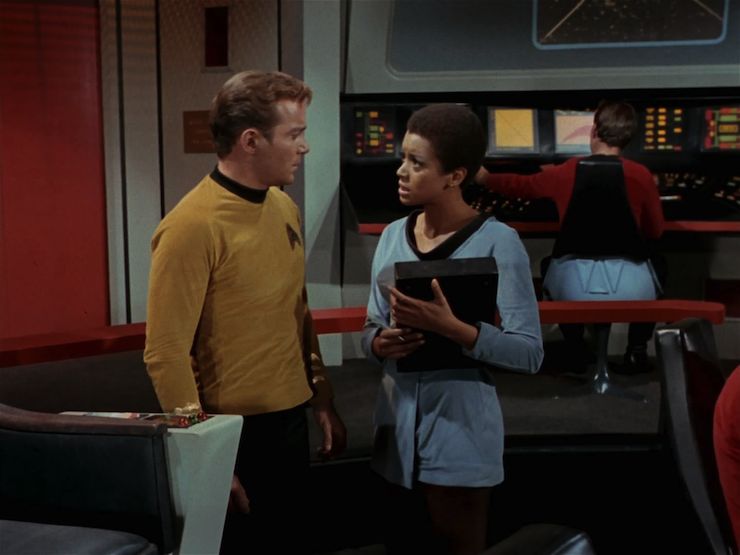
Masters wears science blue even though she’s assigned to engineering, which means she should be wearing operations red. Greg Cox’s novel No Time Like the Past established that Masters was Scotty’s protégé and she was generally left in charge of engineering whenever Scotty was on the bridge.
A different set is used for engineering, one that is never seen again, though it’s referenced in Christopher L. Bennett’s Forgotten History.
Lazarus is seen again in Jeremy Yoder’s cross-series short story “Reborn” in Strange New Worlds 10.
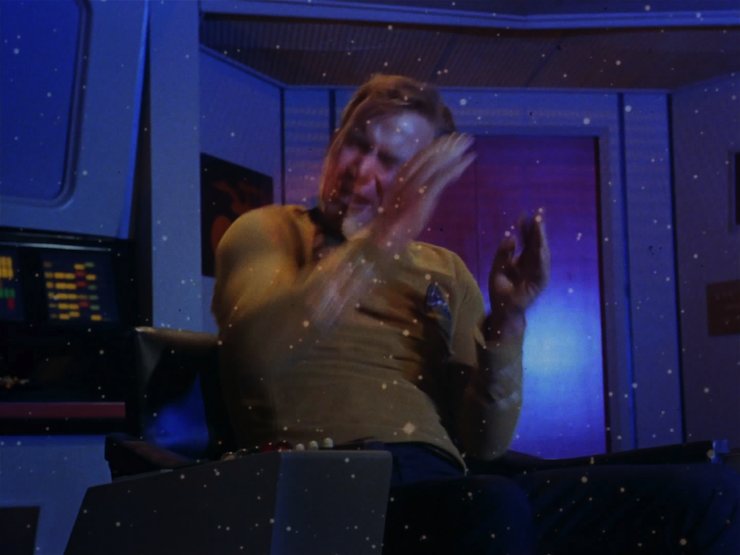
To boldly go. “Captain, the universe is safe.” My graduation present when I finished high school in 1986 was a VCR. One of the first things I wanted to do now that I owned such a device was to record all the episodes of Star Trek onto VHS tapes. At the time, the show was still being aired regularly on Channel 11 here in New York City, and I was able to put six or seven episodes on a tape (depending on whether or not I was able to edit out the commercials, which was only sometimes possible).
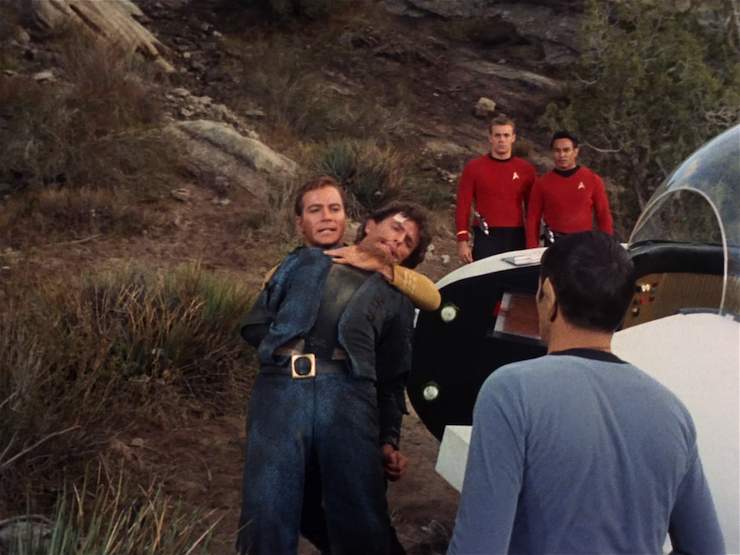
Whatever day it was in 1986 that I recorded “The Alternative Factor” onto VHS was the last time before doing this rewatch that I watched this episode. All I could recall about it thirty years later was that Lazarus’s beard was hilariously inconsistent, that Leonard Nimoy was stuffed up during it, and that it was bad.
All these things remained true, though I had forgotten just how bad it was. There is absolutely nothing in this episode that makes sense. The characters all stumble around like idiots, nobody in the main cast actually does anything until Kirk has his obligatory fistfight with matter-Lazarus. The conversations all contain leaps in logic that aren’t backed by evidence, and there’s an appalling lack of urgency given what’s actually at stake. The time travel element is dropped in out of nowhere and then completely forgotten.
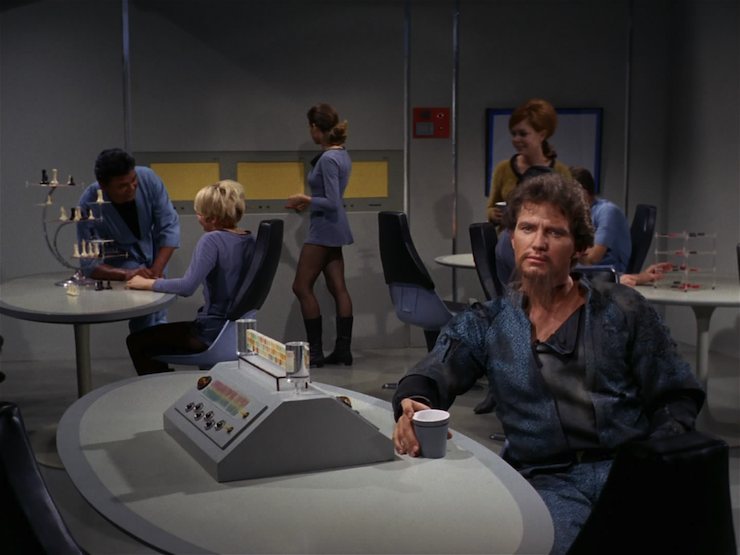
I’m willing to forgive Robert Brown’s horrible performance given that he was a last-minute replacement for John D. Barrymore, who probably didn’t show up because he read the script and decided it was worth not working for six months just to keep this monstrosity off his resumé.
It’s not surprising that this episode is so easily dismissed. Its notions on anti-matter and how the Enterprise is powered are inconsistent with every other reference to same and it’s spectacularly awful. Oh, and also there are apparently no long-term consequences to the entire universe blinking out of existence several times, which probably would have engendered a response from the other governments and beings in the galaxy…
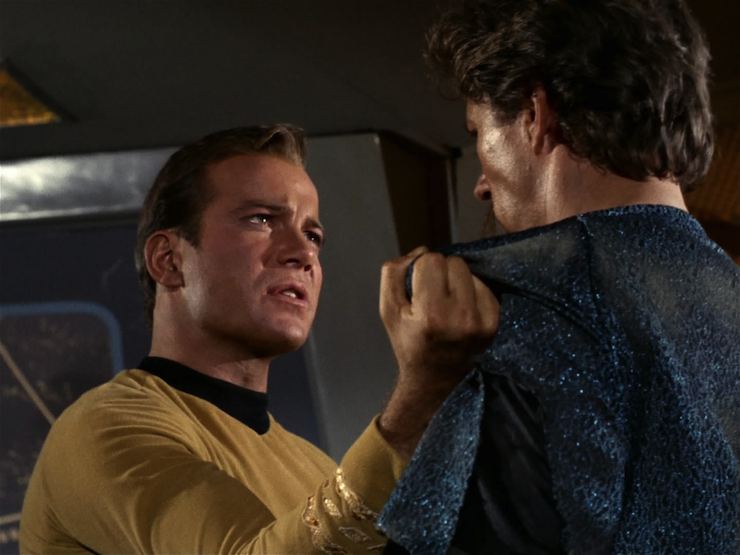
Having said that, the episode does have one redeeming feature that deserves praise, and that’s the character of Lieutenant Charlene Masters. Given her level of responsibility, she seems to be the deputy chief engineer under Scotty, and she’s a black woman, who thinks the coffee on the Enterprise sucks. It’s truly a pity that this character didn’t have the fortune to be in a good episode, as I find myself genuinely curious about her. As it is, the episode is ranked as high as it is only due to her…
Warp factor rating: 2
Next week: “Tomorrow is Yesterday”
Keith R.A. DeCandido urges everyone to support the Kickstarter for a superhero flipbook anthology called The Side of Good/The Side of Evil, for which Keith will be writing a Super City Police Department story, and which will also have a new Furious story by Bryan J.L. Glass, as well as tales by Peter David, Jennifer K. Spendlove, Aaron Rosenberg, Robert Greenberger, James Chambers, Gail Z. Martin, John L. French, James M. Ward, Neal Levin, and Kathleen O. David. The anthology will be edited by veteran anthologist Danielle Ackley-McPhail and Between Books‘s Greg Schauer.










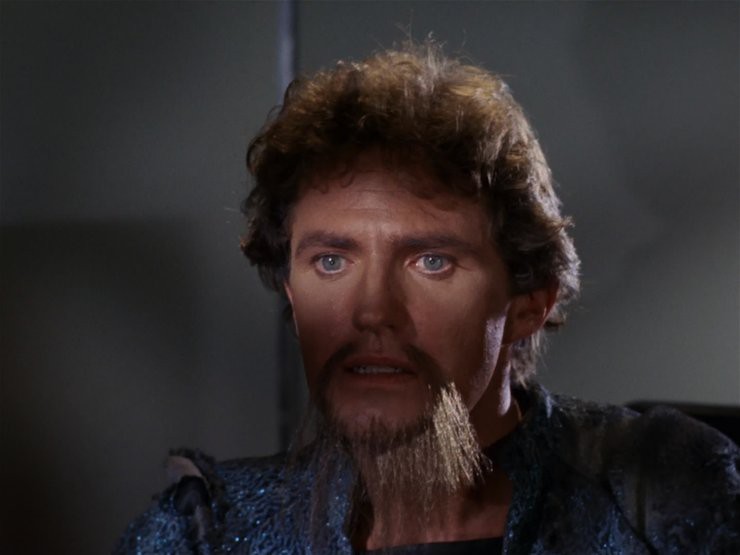
Well you could always watch it for it’s six degrees of Kevin Bacon factor. Robert Brown was in a show with Mark Lenard (Sarek) called Here Comes the Brides. I didn’t realize until I looked it up that they appeared in it until 1968. This is what happens when you watch a lot of re-runs. Oddly enough in one of the tie in novels Spock gets sent back in time to Seattle to interact with all the characters from that show including Lenard. That’s what I remember it for because the episode makes no sense.
As a fan of Masters, I was excited to see she was in a book. Then I saw No Time Like the Past is a TOS-VOY crossover that ends up on Sarpedion. Nope…don’t think I can handle that – sorry, Greg. Somebody really should write more Charlene Masters, though.
The inconsistent beard and Nimoy’s cold are actually my favorite things about this episode. Not, y’know, the plot, the dialogue, the special effects…
This episode desperately wants to be a mirror universe story, but it utterly fails…
@1/RobinM – For reference, that’s Barbara Hambly’s Ishmael from 1985. Among the stranger Trek tie-in novels, IMHO…
The only two things redeeming about this episode are Masters and getting to see Leslie in command again after “Squire”. Other than that, this episode is a total turd. I’m not sure this episode even warrants a warp factor rating, maybe more like “Full Impulse”…
Full impulse? I’d rate it a Sandra Bullock space fire extinguisher. Just a puff of an episode.
In my top-three list for the Very Worst Episodes of STAR TREK, sharing the honors with “That Which Survives” and “The Cloud Minders.”
When I screened the entire series for my daughter, who was eight at the time, I intentionally left out “The Alternative Factor” from Season One–I didn’t want to scare her off! (http://glenngreenbergsgrumblings.blogspot.com/2011/03/star-trek-through-fresh-eyes-part-one.html)
I finally screened it for her after we completed TOS in its entirety (TOS, TAS, and the six TOS movies), and presented it as “one last adventure,” almost like a “lost episode.” I hoped it would not be as bad as I remembered.
It was.
And my daughter’s opinion was no different from mine.
The only thing I found notable about the episode was that unique, rear shot of the Enterprise firing its phasers, which was never used again in the series.
Since this is the only time that Lesley EVER gets screen credit, I consider all the books and comics to be the ones that spelled his name wrong.
Hmmm…this could be a good movie idea like Kahn was.
To me, the biggest problem with this episode is that it is mind-numbingly BORING! There’s zero tension. I always remember this one as the one with the small ship on Vasquez Rocks. Slowly paced, poorly written, poorly characterized.
At least Spock’s Brain makes me laugh.
I’ll be succinct:
I hated this episode when I was a kid
I still hate this episode as an adult
Grade: 1
@@@@@ 3 MeredithP: “For reference, that’s Barbara Hambly’s Ishmael from 1985. Among the stranger Trek tie-in novels, IMHO…”
I like its quirkiness.Maverick and the Cartwright’s (from Bonanza) make cameos.And, best of all, Spock plays chess with Paladin, the hero of my all-time favorite Western, Have Gun-Will Travel
Keith, there is no original music in this episode. The sting that accompanies the spinning “tunnel” is Fred Steiner’s “Zap Sam” from “Charlie X.” The music accompanying the Lazarus fight is Alexander Courage’s “Situation Grave” from the climactic fight of “Where No Man Has Gone Before.” Quite a lot of the music in this one is tracked from “Where No Man.”
But yes, I agree completely about the quality of the episode. It makes no damn sense even within itself. Sometimes the transfer between universes has to happen on the planet and causes universe-wide chaos, and sometimes it happens on the ship with nobody noticing. The script can’t make up its own mind.
Given that nothing from this episode — beyond the term “dilithium” itself — has ever been referenced in any subsequent Trek production, and given that its version of antimatter and dilithium’s function have been contradicted consistently ever since, I think we can safely count this episode as unofficially apocryphal, an episode so awful that the producers themselves quietly swept it under the rug — much like Voyager‘s “Threshold” decades later.
TAF is the only episode with a time-travel theme that I never referenced in my DTI books — not because I consider it apocryphal (though I do), but because the idea of Lazarus as a time traveler is such an ill-developed throwaway element of the story that I’d simply forgotten about it. The idea of one person relentlessly chasing an enemy through time sounds as if it could’ve been very interesting, but it’s just a few sentences that never get any follow-through.
As a kid watching this episode the first thing I thought was wrong was that whenever either Lazarus set foot on the planet of his counterpart’s universe, or when Kirk set foot on the anti-matter planet, the individual and the ground (and possibly the air around them) should have blown up, even if the whole universe(s) didn’t. For that matter (pun intended) how could these people even breathe the air in the wrong universe?
And when I happened to watch the episode again years later and heard Uhura say “Security reports Lazarus missing” I wondered how they could be incompetent enough to let him out of their sight.
Of course these things turned out to be just the tip of the iceberg.
@13/richf: And you’ve pointed out one of the stupidest things about the episode’s take on antimatter. In its view, it isn’t equivalent particles of matter and antimatter that will annihilate each other, but only equivalent people or macroscopic objects. Positive Kirk can touch Negative Lazarus, but Positive Lazarus and Negative Lazarus would annihilate, as presumably would Positive Kirk and Negative Kirk. Presumably, say, Positive Kirk’s communicator would annihilate with Negative Kirk’s anti-communicator, but not with Negative Spock’s anti-communicator. And so forth. It’s a totally silly interpretation of how matter and antimatter work.
I forgot to mention – this is also one of the times I like the original effect better than the remastered version. The original was a bit clearer and a bit more themely. The remastered one is just a blue blob with some different blue blobs moving around.
#14: Then again, the episode arguably anticipates the formulation of the Blinovitch Limitation Effect as evolved in Doctor Who….
@15/MeredithP: By the way, the space image that’s superimposed on the screen to represent the dimensional warp is simply a photo of the Trifid Nebula.
I recently did my own watch of TOS – not a re-watch, as most of the episodes I was seeing for the first time. When I got to this episode, I thought it made absolutely no sense whatsoever, and was boring to boot. After watching the remainder of the series, I decided that Alternative Factor was my least favorite TOS episode. Though Plato’s Stepchildren was a very close contender for that (dis)honor.
This is my first comment on any of your reviews, as though I’m now re-watching TNG and DS9 (and happily reading your reviews of those episodes), I feel weird commenting on posts made several years ago!
I figured the time travel bit was Crazy Lazarus trying to throw out another story to cover his lies/delusions. But, I also figured the pair meeting created some kind of wibbly-wobbly, dimensional-wimey paradoxy thingy. Matter/anti-matter not involved.
It might have been good as a ten or fifteen minute short. A smaller scale danger (the instability could threaten the Enterprise or maybe just destroy a few crew members), some better background and motivation (maybe Sane Lazarus invented dimension travelling just ahead of Crazy and accidentally snuffed out Crazy’s family when he crossed over. Crazy is trying to get revenge or snuff out Sane’s family–or steal Sane’s life by reaching his universe first), and no showing us the two fighting but build a little suspense as we try to figure out what’s going on would have also helped.
Or maybe this is a Humpty-Dumpty episode, and all the king’s horses and all the king’s men couldn’t save it.
Ishmael, by they way, has cameos by the fourth Doctor and Romana, Starbuck, Apollo, Little Joe, Hoss, the second Doctor, one of the second Doctor’s companions, Paladin from Have Gun, Will Travel, and the Hokas from Dickson and Anderson’s short stories. It’s a fun book.
When I first watched this one, I kept wondering what had happened that I missed or wasn’t paying attention to, because I could not understand what was going on.
The next time I saw it, I understood why!
@MeredithP #2–No Time Like the Past is actually a pretty entertaining book! At least to me, it was! It had Kirk and Seven (as in “of Nine” not as in “Gary”) covering quite a bit of temporal ground together.
@ChristopherLBennett #12–Yea I remember Threshold being quite a clunker! They should have called that one “Let’s Figure Out A Perfectly Workable Way to Get Home and Then Totally Not Realize We Found A Way Home.”
@12/Christopher: I agree with Ellynne – there is no time travel theme in this episode. Lazarus, being paranoid, thinks that any lie will serve him better than the truth, so when his first lie fails, he makes up another one. I imagine that Kirk never believes a word of it, which is why it isn’t mentioned again. So this particular bit of the episode actually makes sense (to me).
@Anybody who ranks this as their worst episode: Come on – this is merely boring and nonsensical, AND it has a cool female black engineer (who thankfully doesn’t get a romance with Lazarus), and a nifty little interdimensional ship on top of it. A female engineer is almost as good as a female starship captain. And there’s worse than boring and nonsensical yet to come. (Besides, I like The Cloud Minders).
If I had been anti-matter Lazarus, I think I would have killed myself. That should solve the problem just as well and seems preferable to spending an eternity in that corridor.
I’ll always remember how, when Lazarus shows up, he’s repeatedly screaming “Kill, kill, kill!” and yet the characters don’t treat him like he should be physically restrained from minute one. And yeah, the matter/antimatter nonsense just takes it further downhill.
-Andy
@@@@@ 22: JanaJansen:”Anybody who ranks this as their worst episode: Come on – this is merely boring and nonsensical,”
Well, we are talking about a show that is supposed to be entertaining, so being “boring and nonsensical” are pretty big sins.
Christopher: thanks for the musical correction. I’ve cut that paragraph….
—Keith R.A. DeCandido
@Anybody who ranks this as their worst episode: Come on – this is merely boring and nonsensical
@22: But that’s exactly the problem. When I watch an outrageously bad show like DS9’s Profit and Lace, VOY’s Threshold or TNG’s Code of Honor, I can find scenes, characters and situations that make me laugh. Same with shows like Spock’s Brain. They’re so inherently bad, you can translate them into humorous viewing experiences. The absurdity helps.
Alternative Factor can’t even achieve that. The story’s poorly paced with the same situation repeating itself over and over again. You used the word boring, which describes the feeling well. Boring puts me to sleep, and to me boring can score lower than bad.
Keith scored the episode 2. To me, this was a very round 0.
@26 Eduardo Jencarelli:”You used the word boring, which describes the feeling well. Boring puts me to sleep, and to me boring can score lower than bad.”
Yeah, bad stories can still be entertaining, but boring stories are just unendurable.
I’ve always loved this episode solely because of Lt. Masters! She was just such a cool character – and she had a great look, too – the short afro just looks chic and groovy with that uniform. The fact that she is a female engineer with some degree of authority is just pure awesomeness. I have had a fangirl crush on her since I was a kid.
Then again, I tend to develop irrational fangirl crushes on one-off female Trek characters all the time, like. Ensign Tate or Lt. Stahdi.
As to why Masters is in a blue uniform and not red, I suspect that has something to do with the producers not expecting the 1960’s audience to be able to handle TWO female black officers in red uniforms in one episode. We can only expect our audience to be so progressive at any time, dontcha know.
@24/trajan23, @26/Eduardo: I agree that bad stories can be entertaining, but I wasn’t thinking of stories like Threshold or Spock’s Brain – I was thinking of stories I find downright offensive, which to me is worse than boring. I prefer sleeping to being pissed :-)
For example, in the first scene of Wolf in the Fold, we learn that Scotty suffers from “total resentment toward women” because ” the explosion that threw Scotty against a bulkhead was caused by a woman”, and both Kirk and McCoy seem to think that this is a perfectly natural reaction. I guess we are all very fortunate that the explosion wasn’t caused by a Jew, but on the other hand, in that case even Robert Bloch might have noticed how distasteful the entire affair is. That’s worse than boring in my book. But of course, there’s no accounting for taste.
@29: Offensive is a different ballpark. To me, gets into the issue of projecting one’s personal views into a work of fiction. For all intents and purposes, I prefer to let a story speak to the audience and provoke a reaction. As a writer, I try to remain neutral and open-minded to any developments, especially if something comes across as offensive, and especially when it comes to fiction. Profit and Lace is downright nauseating in its attempt to address male/female differences for comedic effect, but the writers didn’t deliberately set out to do a bad show.
As for Wolf in the Fold, this was written in the 1960’s, a time when it was still acceptable to design characters in a sexist fashion. Nick Meyer once put it best: fiction is a product of the time it was made in. Projecting 2015 sensibilities into a 50 year old show isn’t a foolproof process.
And there are stories out there that can display reprehensible actions which happen to be the whole point of the story being told. Most of Von Trier’s films fall into this category. Are the acts of violence and sex in those films gratuitous and potentially offensive? Most likely, but I’d still watch them for a number of different reasons.
I prefer to feel offended over real-world developments, but then again, this is only how I feel. I’d rather watch offensive fictional material instead of a boring toothless hour of television. At least, I’d feel mentally stimulated.
@29: JanaJansen:”I was thinking of stories I find downright offensive, which to me is worse than boring. I prefer sleeping to being pissed :-)”
I’m the other way around.I would rather watch Gone With The Wind than “The Alternative Factor.”The former is as offensive as all Hell, but it is well made and never boring.
“For example, in the first scene of Wolf in the Fold, we learn that Scotty suffers from “total resentment toward women” because ” the explosion that threw Scotty against a bulkhead was caused by a woman”, and both Kirk and McCoy seem to think that this is a perfectly natural reaction. I guess we are all very fortunate that the explosion wasn’t caused by a Jew, but on the other hand, in that case even Robert Bloch might have noticed how distasteful the entire affair is.”
I find that more stupid than distasteful; Bloch wanted to do his old standby plot (“Yours Truly, Jack the Ripper”) and someone (Bloch? Roddenberry?) decided that it would be more effective if Scotty (as opposed to a guest star) was a suspect.Since it was Scotty, some rationale had to found for making him a potential serial killer.Hence, the “getting-knocked-on-the-head-has-left-me-irrationally-resentful-towards-women” device.Standard Silver Age comic book stuff, like when radiation turned the Angel evil (Ah, radiation, what can’t you do?) and made him fight Iron Man in Tales of Suspense 49
If we’re talking offensiveness, I can think of even worse TOS episodes than Wolf in the Fold, even accounting for 1960s-era values. Paradise Syndrome, for example. And I found Plato’s Stepchildren to be literally painful to watch, unlike Spock’s Brain which was just pure silliness. I’d actually willingly watch Spock’s Brain again.
But Alternative Factor is still my least favorite because it has no redeeming value whatsoever. Even the cool black female engineer could not rescue it from the bottom of my personal heap (and I’m queer black trans guy, for the record).
I had totally forgotten Lt. Masters. I remember the episode, but not her. Even the picture doesn’t look familiar. That is so odd.
I guess it comes down to personal taste. And @32/Pax Ahimsa Gethen, I didn’t mean that this is the worst example – it was just the first one that occurred to me. The sexualized shaman in A Private Little War and the whole Asian-versus-whites stuff in The Omega Glory is also pretty horrible. I prefer boring to any of that.
Oh, and I would also watch Spock’s Brain again. Silly is still better than boring.
I once considered writing a fanfic where Lazarus somehow showed up again to help the Voyager get home, but sanity prevailed.
I do like one thing about this episode (apart from, as many have noted, the progressive presence of cool character Lt. Masters): Hallmark published a funny birthday card several years ago that used the “Annihilation, Jim… pure annihilation” sound clip from Spock as a punchline about the number of candles on a birthday cake being lit at once.
Well, I guess I’m the lone oddball who kinda likes the episode, not for the plot or story or dialogue, but for, other than the awesomeness of Lieutenant Charlene Masters, the weird, almost Twilight Zone-y feel of the episode. Everyone seems oddly calm about the universe possibly being destroyed, but the ship is on red alert for most of the episode. The whole trapped-for-eternity thing really struck me, especially as a kid. But I have to admit there’s really not much to redeem this episode other than Masters, whom I really wish we’d seen more of.
I will say, “Plato’s Stepchildren” is much much worse, at least to me.
The rewatch for “Tomorrow is Yesterday” has collided with a black star and traveled forward in time to tomorrow.
—Keith R.A. DeCandido
100% agreed: terrible episode !
And why is everyone so sweaty? No a/c on the Enterprise ?
This episode was cursed from the moment that original guest star John Barrymore showed up drunk and had to be fired. Then the network went nuts over Masters (who I agree was the best thing in the episode; wish we could have seen her again) having a romance with Lazarus. But they were already too far into it then. So, IMHO and in a manner what’s familiar to anyone facing project deadlines, the producers finished it knowing it was a dog, and buried it until they had nothing else ready to show – the week after they’d blown out the budget on “City to the Edge of Forever”.
The best thing I can say about this episode, other than the well-deserved praise that Janet MacLachlan’s performance as Lt. Charlene Masters has already received, is that the dimensional warp effect that gets used about four times too many bears a strong resemblance to the cover of the album “Islands” by the progressive rock group King Crimson. Even this manages to be a baleful gift, as it only serves to remind me that I would rather be listening to Fripp & Co. shred than watching this utterly incoherent episode.
@41/DoubleRedAlert: As I said in post #17, that’s simply a photo of the Trifid Nebula. It looks the same because it is the same.
I watched this episode last night and noted that it was named “And What of Lazarus”, a line used 3 times near the end. Why do all sources call the episode “The Alternative Factor”?
@43/Richard Brummel: I don’t understand the question. It’s always been called “The Alternative Factor.” That’s its onscreen title. I don’t know where you got the impression that it had another. I suppose maybe some overseas release might have changed the title, but I can’t find any reference to that title being used. Of the overseas titles listed in the 1995 Star Trek Concordance, most are just translations of “The Alternative Factor,” aside from the Italian title (which translates as “The Alternative”), the Japanese title (“Two Universes”), and the rather poetic alternate titles in Germany (“On a Razor’s Edge”) and France (“The Twins of the Apocalypse”).
I saw the episode originally in parts, due to other obligations and the era being pre-VCRs DVRs, etc. It really is better that way! I loved Charlene Masters, though! Reading that she was originally supposed to have a romantic thing going on saddens me, because she was the only woman on the original series who seemed to be in charge of her area and all about the work, which was how the males were generally presented.
This is truly a pointless episode that makes absolutely no sense. But ironically, one of the things that makes it such bad television is one of the reasons I enjoy watching it: It’s relaxing. It’s like watching a baseball game. No one’s in a hurry. Characters come and go. They sit down and have a conversation. There’s an occasional, um, “action?” scene to punctuate it, but for the most part it’s just a chance to sit back and enjoy the 60s set pieces. It helps that the episode is just dumb rather than being offensively bad. It’s like Tron — just don’t think about it too much and chill out.
Hmm…I wasn’t thinking in terms of drug use when I wrote that, but it was the 60s. Trippy episode?
I remember spending this entire episode thinking, It that’s not how antimatter works! I was fifteen.
And when I wasn’t thinking about how they’d gotten anti-matter wrong I was thinking what a truly awful beard that was.
I am going to flamed for this, but this was always one of my favorite episodes BECAUSE it is so weird and nonsensical. I can’t really put my finger on it, but I just love it. And I think the conversation between Anti Laz and Kirk in the anti Universe is great, especially when Kirk asks him, “ So you’re the terrible thing? The creature? The murdering monster?” And Anti Laz’ reply, “Yes, Captain. Or he is. It depends on your point of view, doesn’t it?”
Considering what Anti Laz sacrifices, it makes him one of the greatest heroes of the Universe.
Charlie: No flames here. You’re entitled to like whatever you want. That’s what makes the universe such a nifty place. Nobody likes everything, and everything is liked by somebody.
—Keith R.A. DeCandido
Maybe this episode is so bad in the “so bad, it’s good” kinda way? I think I may just give it a spin right now! And hopefully I don’t regret it as there are still a ton of TOS entries I have yet to see, a lot of which are obviously considered much better than this one! One bad episode in the entire first season is a pretty impressive track record though.
@51/GarretH: “Maybe this episode is so bad in the “so bad, it’s good” kinda way?”
No. Definitely not. “Spock’s Brain” is so bad, it’s good. “The Alternative Factor” is just a tedious, incoherent slog.
“What of Lazarus?”
WHO FUCKIN’ CARES! Lol
@52/CLB: Okay, this one was a turkey for sure and a slog. That sure was a loooong 50 minutes! However, there were still some moments of unintentional humor, even though it doesn’t approach “Spock’s Brain” hilarity and kitsch. I enjoyed Lazarus’ thickening and thinning beard, the cosmic judo that the two Lazarus’ would do whenever they came into contact, the ludicrous universe spinning effect, and the passivity of the transporter chief weakly telling Lazarus: “You’re not supposed to be in here, sir,” before being whacked. Also, Lazarus’ UFO-looking ship was cute. Plus it was very progressive having the Black female engineer. This episode’s biggest sin though, aside from being boring, is that it wasn’t about any of the main characters or had anything revealing to say about them. That should always be a no-no. So I can say I definitely say this is one episode I will never watch again (unless forced to do so).
@53/GarretH: “This episode’s biggest sin though, aside from being boring, is that it wasn’t about any of the main characters or had anything revealing to say about them. That should always be a no-no.”
In ’60s TV, not so much. The classiest shows in early TV were the anthologies, so even shows with continuing characters liked to take an anthology-like approach. It made sense in a time when they didn’t have home video recorders or season box sets or even that many reruns, so that if you missed an episode, you might never see it. So the ideal was for each episode to tell a complete story on its own, not dependent on anything else, so that lent itself to an anthology-like format where fairly unchanging main characters catalyzed or supported stories about the guest stars of the week going through life-changing journeys. This is why you got a lot of shows mimicking the formula of The Fugitive where the main character wanders from town to town and gets involved with different people’s problems, or a show like Mission: Impossible where the heroes were literally pretending to be completely different people every week and their personal lives were complete ciphers.
Indeed, part of the reason Roddenberry pitched ST as “Wagon Train to the stars” is because Wagon Train was a classy, successful drama famous for its anthology-like focus where almost every episode was literally titled “The [Guest Star of the Week] Story.” People today think he just meant “Western in space,” but half the shows on TV at the time were Westerns, so that would’ve been a trivial thing to specify. It was the anthology-style focus that he wanted to emphasize. And you can see that a lot of first-season episodes do revolve mainly around the guest stars — “Where No Man Has Gone Before” on Mitchell and Dehner, “Mudd’s Women” on Mudd and Eve, “Charlie X” on the title character, etc. It was only later, when Spock became a runaway sensation and the network pressured the show to focus on him, that it ended up becoming centered mainly on Spock and his two closest friends, Kirk and McCoy.
Oh, I also liked the on-location filming at Vasquez Rocks. I recently moved to Southern California and it would be fun to check out the scene of so many Trek productions!
@54/CLB: Thanks for the historical context. I think my judgment of whether a TV episode is successful or not became aligned with Michael Piller’s takeover as showrunner of TNG in the 3rd season and his mandate that the story should be about our heroes, otherwise why do it? There would be the occasional exception though like “Power Play” where it was just a fun shoot ‘em show for sweeps week. But generally, if it was a story like “Too Short a Season” which completely revolved around the guest star, I too would not care since it’s not about any of the main characters.
@56/GarretH: Another exception that worked amazingly well was TNG: “Half a Life,” which revolved entirely around two guest characters (Lwaxana and Timicin), only one of them recurring.
@57/CLB: Right. I thought “Half a Life” was a good exception to the (Michael Piller) rule because Lwaxana was like a family member (to us, the audience, and literally to one of the senior officers), and she had been recurring as you mentioned, and it gave her much needed depth. Also, it was actually a good episode and poignant, in my opinion.
Even if this episode had made sense, Lazarus beard inconsistency was too comically noticeable. I don’t think I would have been able to pay attention to the plot anyway…
@32 Pax Ahimsa Gethen: What was offensive about Paradise Syndrome?
Alex: “The Paradise Syndrome” was hugely offensive in its portrayal of Indigenous people……..
—Keith R.A. DeCandido
I’ve been randomly watching some TOS episodes recently and happened to choose this one. What a bore. I did like the special effect when they reversed the film stock (or whatever it was they did) and had the 2 guys fighting. That looked cool at least.